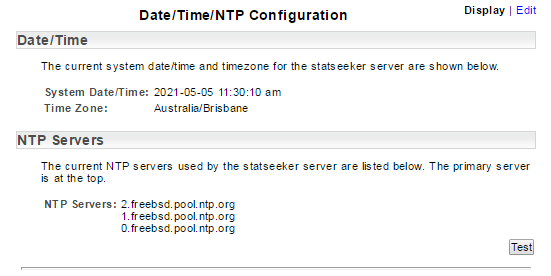*** Legacy Documentation for Statseeker v5.5.5 ***
Index
- Overview
- Requirements
- Creating a Virtual Machine in Azure
- Server Licensing
- Update Default Passwords
- Network Discovery
Overview
Statseeker can be deployed to the Microsoft Azure platform. This document details the process of creating an Azure Statseeker deployment from the Statseeker listing in the Azure Marketplace.
For details on an Azure deployment using a Statseeker VHD provided by Statseeker Sales/Support, see Microsoft Azure Installation – Statseeker VHD.
- Any screenshots presented, and processes described were accurate at the time of writing this document but may become out-of-date due to changes made to the Azure platform
Requirements
This process requires that you have:
- An Azure subscription with previously configured Azure Resource Groups and Storage Accounts
- An Azure account for that subscription with access to the Azure portal and permission to create Virtual Machines
- A valid Statseeker license (free-trial or production license)
For access to Statseeker licenses suitable for your needs, please contact:
- New accounts: your Regional Sales Manager
- Existing Statseeker Accounts: Statseeker Technical Support
Creating a Virtual Machine in Azure
To create your Statseeker VM:
- Either:
- Login to your azure portal (https://portal.azure.com) and select Dashboard > Marketplace
Or
- Directly browse the Azure Marketplace (https://azuremarketplace.microsoft.com)
- Search for statseeker and, from the search results, select the Statseeker listing
- Click Get it now / Create
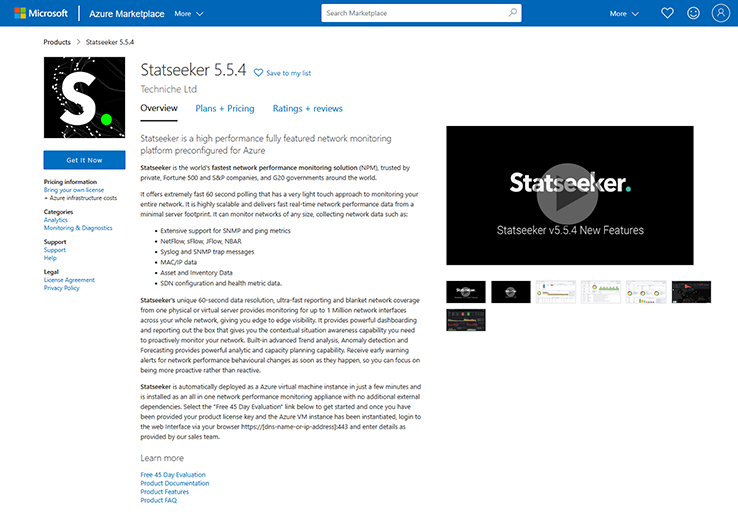
This will display the Virtual Machine configuration page.
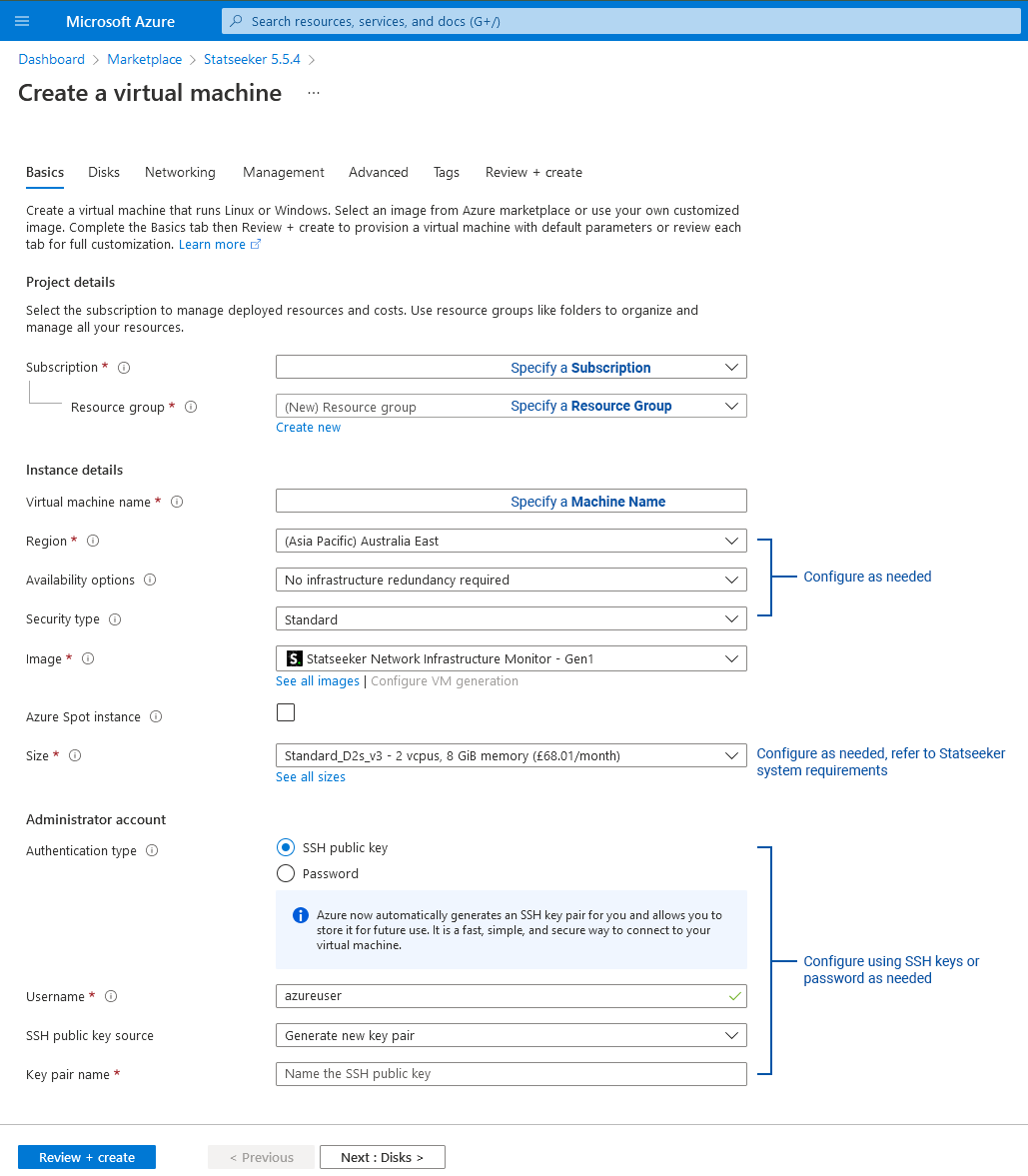
- Select a Subscription and Resource Group to house your Statseeker VM
- Name the VM
- Configure Region, Availability, and Security options as needed
- Specify a VM Size to suit your needs, refer to the Statseeker System Requirements or contact Statseeker Technical Support for guidance
- Configure the VM Administrator Account to suit your requirements (if using SSH, you will be prompted to download the private key when finalizing the VM configuration)
- All subsequent settings (located in other tabs) are optional, assign as required for your environment but it is recommended that you leave Boot Diagnostics enabled
Disk for Data Storage
The default Statseeker disk image only provides a single 512G disk: after boot, OS and swap partitions, we have ~450G for data storage) If you require addition data storage, then add an additional disk to your VM - this additional disk can be flagged for data storage after licensing your Statseeker server. This disk will be used instead of the primary disk, not in addition to it, data storage cannot span multiple disks.
Advanced Tab Options
The Advanced tab provides options for adding custom extensions, applications and scripts to the server post-deployment. Statseeker does not support these additions and they may adversely affect server performance and security.
- Click Review + create
- Review your configuration and click Create when ready
The progress of the creation process is logged on screen, when complete click Go to resource.
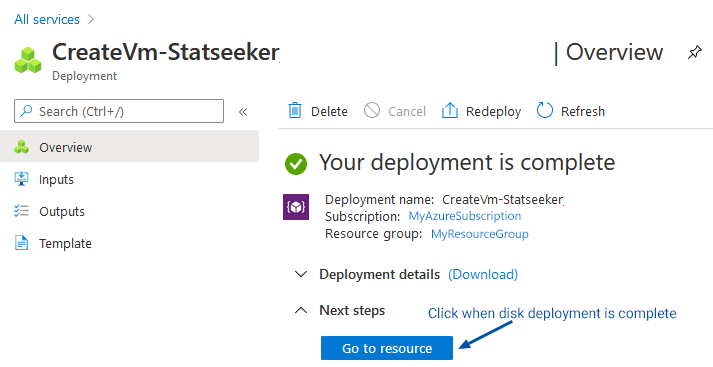
This will take you to the VM page for your new Statseeker server. The VM is built, and the server is booted - allow up to 10mins for the boot process to complete. The Azure interface may state that the process is complete but the Statseeker server may still be running setup processes. To check on the progress of this process:
- Select Help > Boot diagnostics
- Once you see a login prompt on the CLI, your server is ready
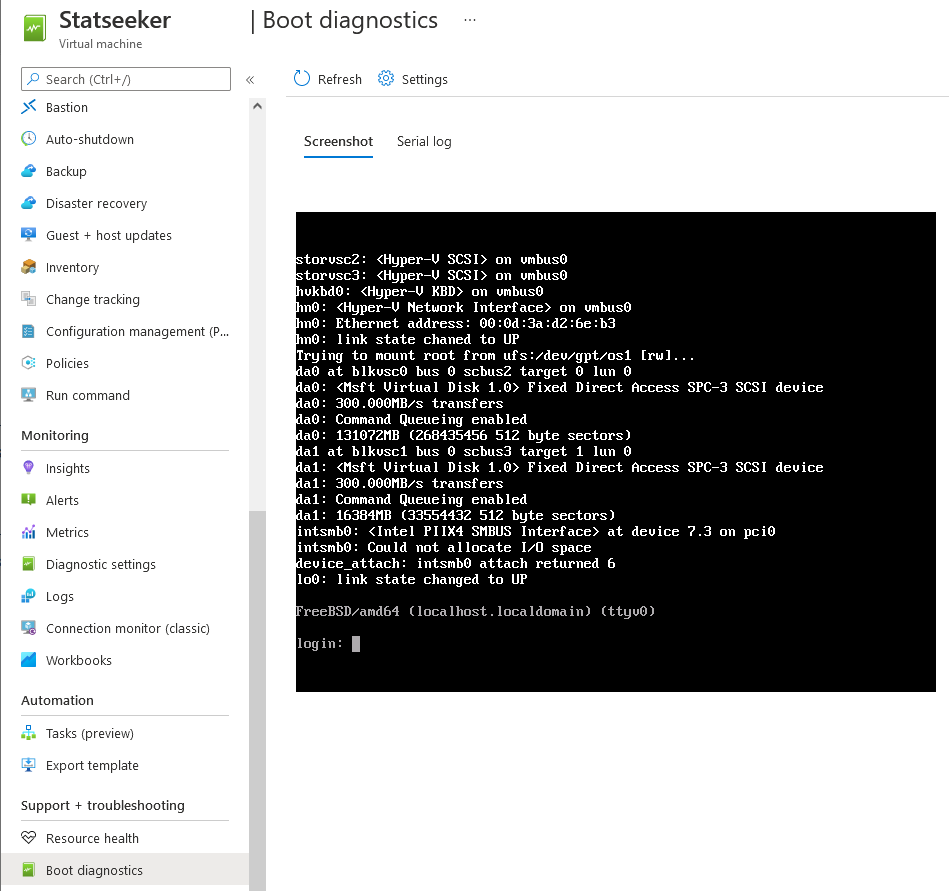
- Use your browser to hit the public IP (https) of the server
Server Licensing
By default, the Statseeker web server will use HTTPS in conjunction with a self-signed certificate. Modern browsers will view self-signed certificates as potentially suspect and post an alert prior to loading the Statseeker interface for the first time. To suppress any future alerts for that specific certificate:browser combination:
- Follow the browser prompts to acknowledge the risk and add an exception for the certificate
For details on how to upload and use alternative SSL certificates, or configure the server to use HTTP instead, see Web Server Configuration.
You will then be prompted with a login screen.

- User Name - admin
- Password - statseeker
Once logged in to the web interface you will be prompted with the Statseeker License configuration screen.
- Enter your Server ID and select Download a new Key
It may take a minute or two to obtain your license key.
- Select the checkbox to accept the Statseeker license
- Select Save to activate the license key
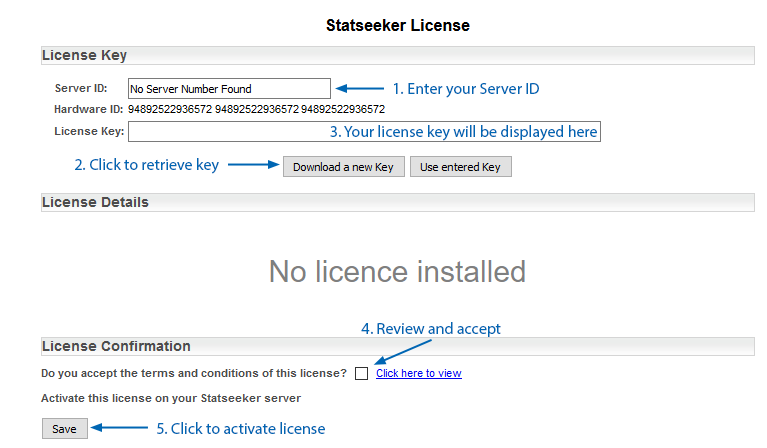
The screen will update to display the license details.

- Click Next
Multi-Disk Servers
If your Statseeker server has multiple disks you will be given the option to assign another disk as the repository for Statseeker data. This screen will only be displayed if Statseeker detects more than one disk.
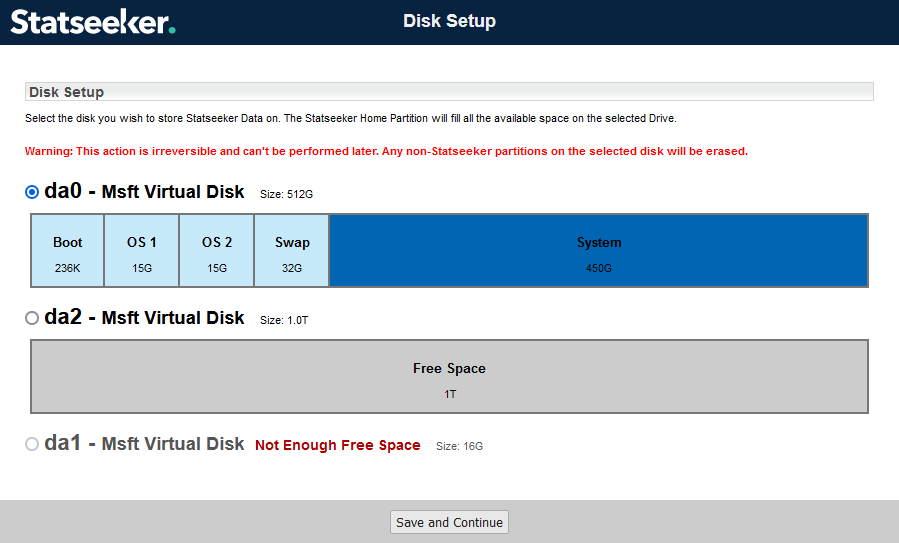
Prepare Secondary Disk for Statseeker Data
Optionally, you can store all Statseeker data on another disk on the server. Assigning a disk as the repository for Statseeker data will delete all current content on the disk.
To store Statseeker data on a second disk:
- Select the disk that will act as the Statseeker data repository - all existing data on this drive will be erased
- Click Save and Continue, then confirm the decision when prompted
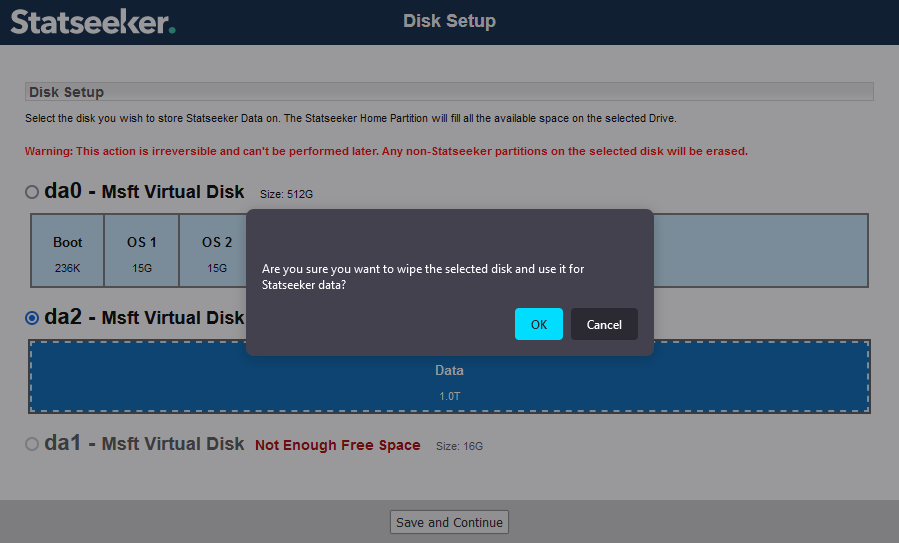
You may need to re-authenticate with the server once this process has been completed.
You will now be presented with the Server Summary screen, containing a range of details pertinent to your Statseeker installation.
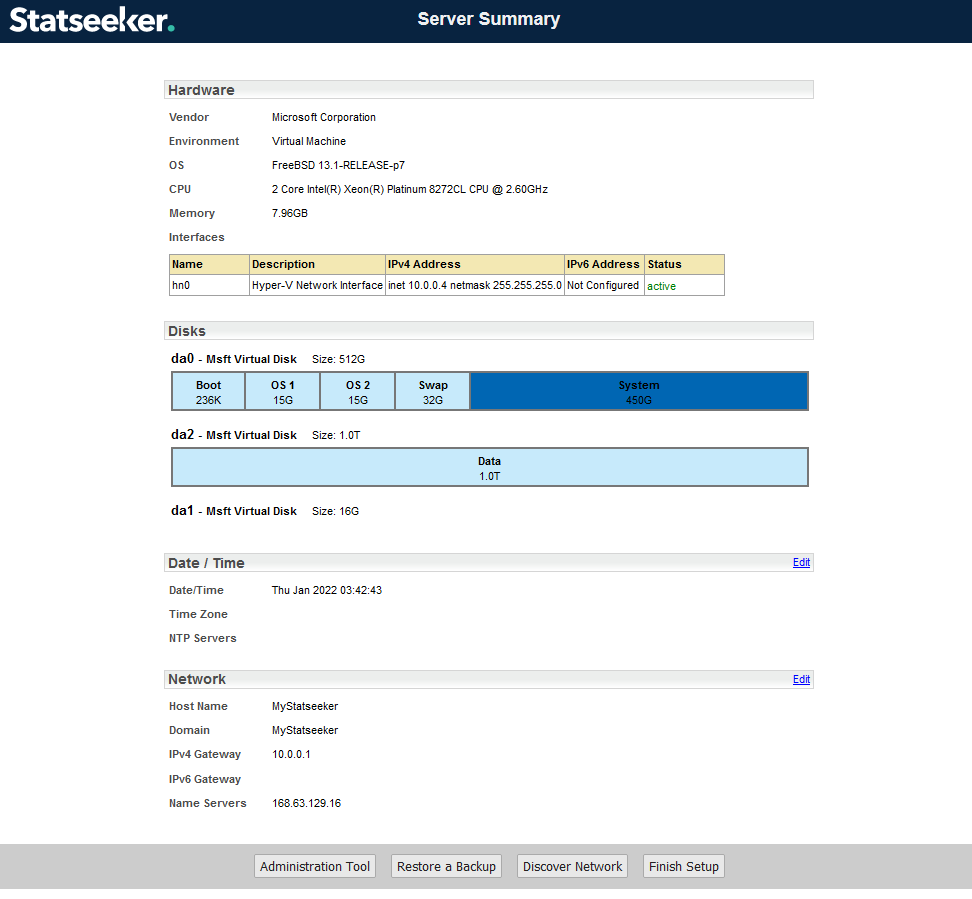
Edit Server Date/Time
To edit the server date/time settings:
- Click the associated Edit link on the Server Summary page
- Use the calendar control to edit the date and/or time
- Use the drop-downs to modify the timezone for the server
- Click Save when done
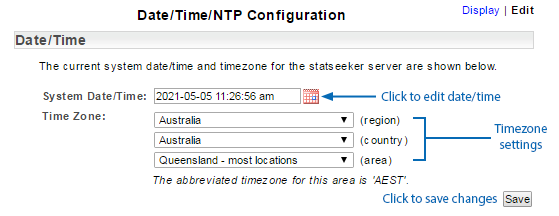
The configuration changes will be saved, and the server will be restarted to apply those changes.
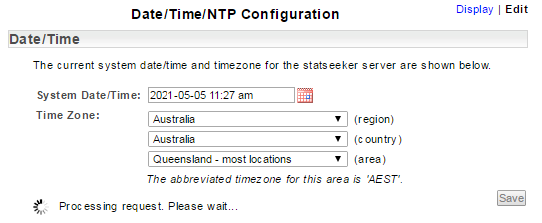

Once the changes have been applied you will be returned to the Date/Time/NTP Configuration screen (in Display mode) to confirm that the changes have been applied correctly.
Edit NTP Configuration
To edit the NTP server settings:
- Click the associated Edit link on the Server Summary page
- Enter the address of the NTP server to use
- Click the associated Delete button to remove unwanted NTP server entries
- Click Save when done
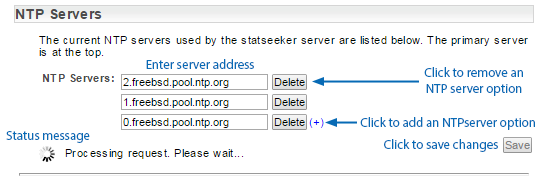
When you click Save Statseeker will attempt to contact the specified NTP servers and:
- Inform you if it is unable to receive a response from the NTP server, no changes have been applied at this point
- If it receives a valid response from the NTP server, apply the changes and return the Date/Time/NTP Configuration screen (in Display mode) and enable a Test button that can be used to confirm the validity of the current configuration.

- Click Finish Setup
Update Default Passwords
The installation process creates the following administrative system accounts:
- admin – the web user administrator account
- statseeker – the system user account used by the Statseeker application
- root – the superuser account in the backend operating system, required for accessing the ssadmin utility
You will need to update the passwords assigned to these accounts. To do this:
- Select Admin Tool > Statseeker Administration > OS Configuration
- Click Edit (top-right)
- Update the passwords for the root, statseeker, and admin accounts
Run Network Discovery
Statseeker's network discovery process is used to add networked devices, interfaces, and other SNMP enabled components on your network to Statseeker. Statseeker can then collect configuration information and timeseries data from those devices to be used for polling, reporting, and alerting purposes. There are several methods that can be used to direct the discovery process towards the devices on your network that you want Statseeker to report on:
- Discover Using Ranges (IPv4) - specify one or more IP address ranges and discover all devices responding to SNMP within that range
- Discover Using Hosts (IPv4/IPv6) – add entries to the hosts file, and run a Discover Using Hosts
- Add A Single Device (IPv4/IPv6) – use the Add Single Device option to individually add IPv4/6 devices
- Add SNMPv3 Devices (IPv4/IPv6) – single or batch addition of SNMPv3 devices
- Add Ping-Only Devices (IPv4/IPv6) – add an IPv4/6 device to be monitored via ping, but not SNMP
Determine the discovery method that best fits your needs and follow the instructions in the associated discovery guide, see Statseeker Network Discovery for details on the discovery process.


